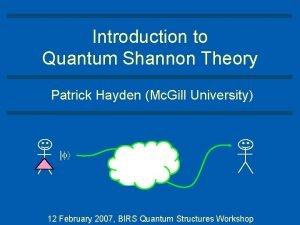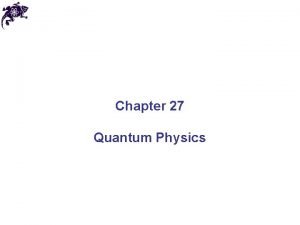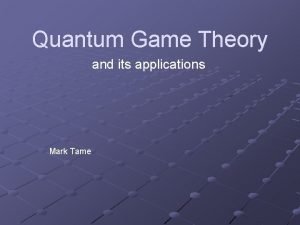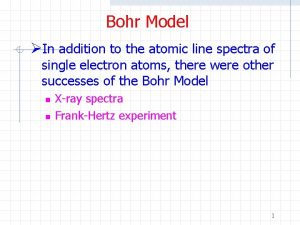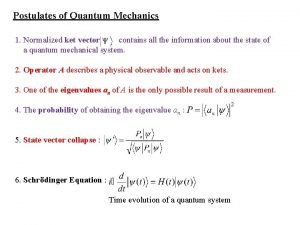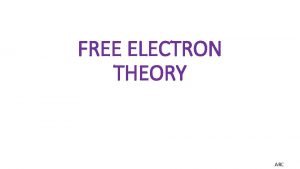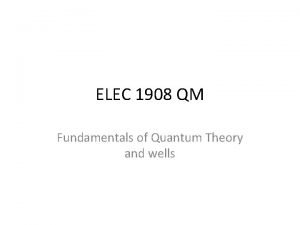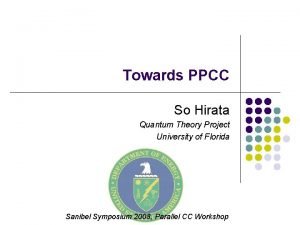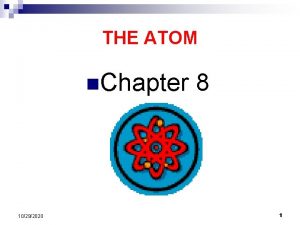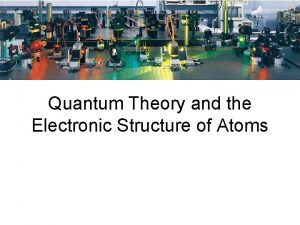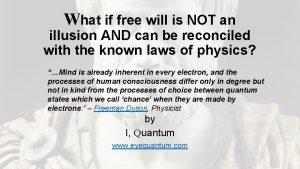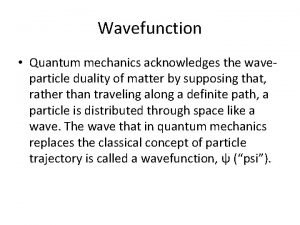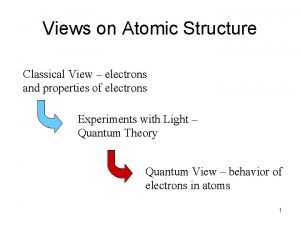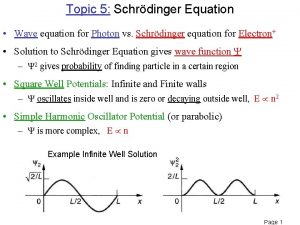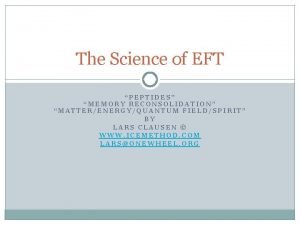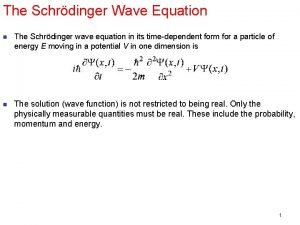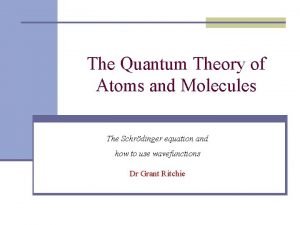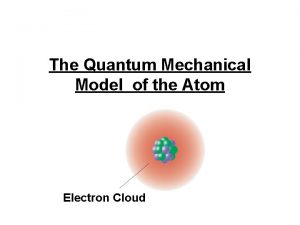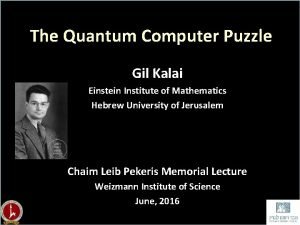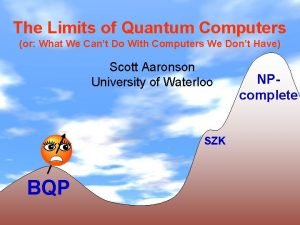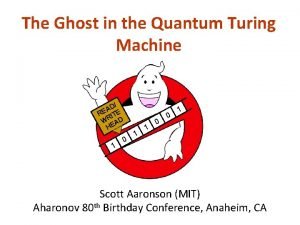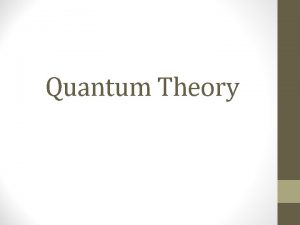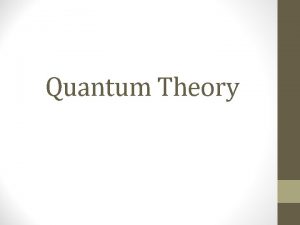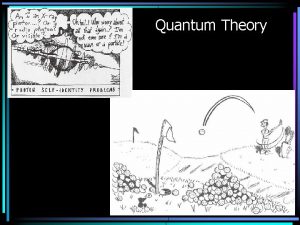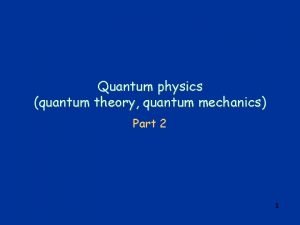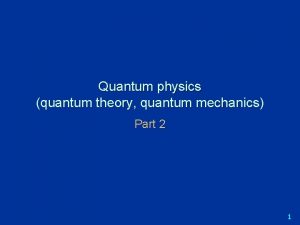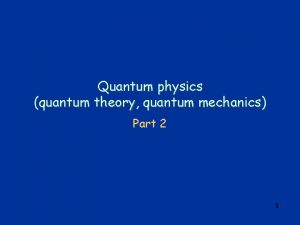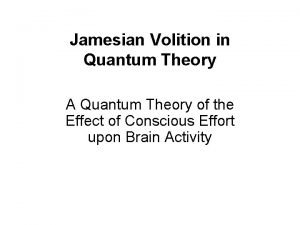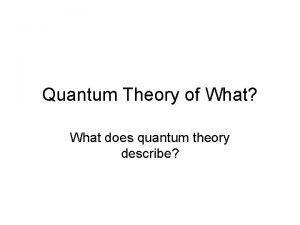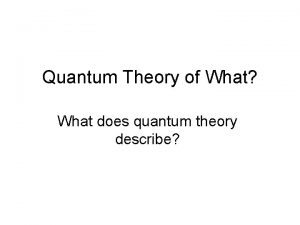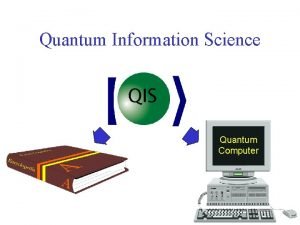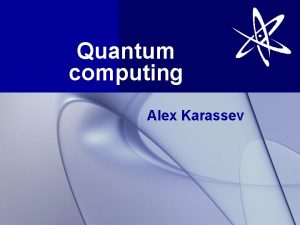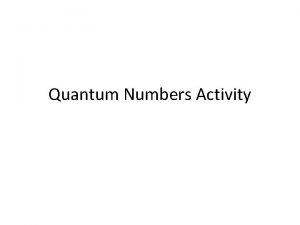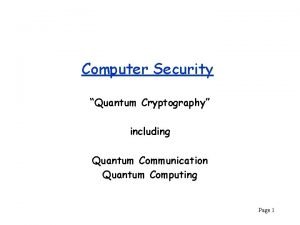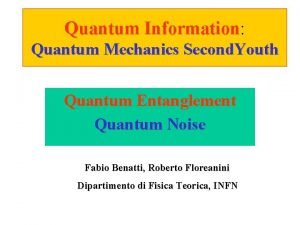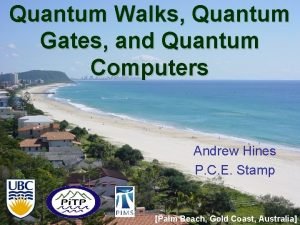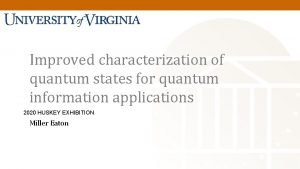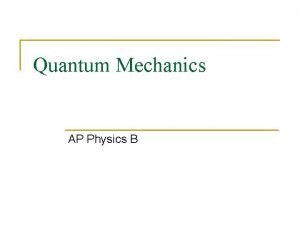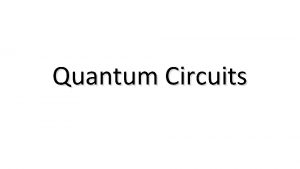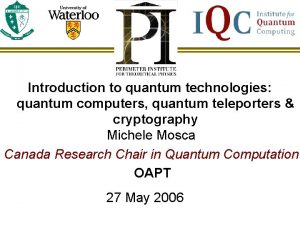Quantum Theory What is Quantum Theory Quantum theory

























- Slides: 25

Quantum Theory

What is Quantum Theory? Quantum theory is a theory needed to describe physics on a microscopic scale, such as on the scale of atoms, molecules, electrons, protons, etc. Classical theories: Newton – Mechanical motion of objects (F = ma) –Particle Maxwell – Light treated as a wave NEITHER OF THESE THEORIES QUITE WORK FOR ATOMS, MOLECULES, ETC. Quantum (from Merriam-Webster) Any of the very small increments or parcels into which many forms of energy are subdivided. Light is a form of energy w/ a quantum of EM energy.

Quantum (from Merriam-Webster) Any of the very small increments or parcels into which many forms of energy are subdivided. Light is a form of energy w/ a quantum of EM energy. Each quantum is associated with the energy level energy differences surrounding the source atom providing the light.

The Wave – Particle Duality OR

Light Waves Until about 1900, the classical wave theory of light described most observed phenomenon. Light waves: Characterized by: Ø Amplitude (A) Ø Frequency (f) Ø Wavelength (l) Energy of wave a A 2

And then there was a problem… In the early 20 th century, several effects were observed which could not be understood using the wave theory of light. Two of the more influential observations were: 1) The Photo-Electric Effect 2) The Compton Effect I will describe each of these today…

Photoelectric Effect (I) “Classical” Method What if we try this ? Increase energy by increasing amplitude Vary wavelength, fixed amplitude electrons emitted ? No No electrons emitted ? No Yes, with low KE Yes, with high KE No electrons were emitted until the frequency of the light exceeded a critical frequency, at which point electrons were emitted from the surface! (Recall: small l = high f )

Photoelectric Effect (II) q Electrons are attracted to the (positively charged) nucleus by the electrical force q In metals, the outermost electrons are not tightly bound, and can be easily “liberated” from the shackles of its atom. q It just takes sufficient energy… Classically, we increase the energy of an EM wave by increasing the intensity (e. g. brightness) Energy a A 2 But this doesn’t work ? ?

Photo. Electric Effect (III) q An alternate view is that light is acting like a particle q The light particle must have sufficient energy to “free” the electron from the atom. q Increasing the Amplitude is simply increasing the number of light particles, but its NOT increasing the energy of each one! Increasing the Amplitude does diddly-squat! q However, if the energy of these “light particle” is related to their frequency, this would explain why higher frequency light can knock the electrons out of their atoms, but low frequency light cannot…

Photo-Electric Effect (IV) q In this “quantum-mechanical” picture, the energy of the light particle (photon) must overcome the binding energy of the electron to the nucleus. q. The energy of the photon is given by E=hf, where the constant h = 6. 6 x 10 -34 [J s] is Planck’s constant. “Light particle” Before Collision After Collision

Photons q Quantum theory describes light as a particle called a photon q According to quantum theory, a photon has an energy given by E = hf = hc/l h = 6. 6 x 10 -34 [J s] Planck’s constant, after the scientist Max Planck. q The energy of the light is proportional to the frequency (inversely proportional to the wavelength) ! The higher the frequency (lower wavelength) the higher the energy of the photon. q 10 photons have an energy equal to ten times a single photon. q Quantum theory describes experiments to astonishing precision, whereas the classical wave description cannot.

The Electromagnetic Spectrum Shortest wavelengths (Most energetic photons) E = hf = hc/l h = 6. 6 x 10 -34 [J*sec] (Planck’s constant) Longest wavelengths (Least energetic photons)

Momentum In physics, there’s another quantity which we hold just as sacred as energy, and this is momentum. For an object with mass, momentum is given by: The units are: [kg] [m/s] == [kg m/s] Unlike energy, which is a scalar, momentum is a vector. That is it has both magnitude & direction. The direction is along the direction of the velocity vector. The reason it is important in physics, is, because like Energy: TOTAL MOMENTUM IS ALWAYS CONSERVED

Do photons carry momentum ? De. Broglie’s proposed that the a photon not only carries energy, but also carries momentum. But, p = mv, and photon’s have m=0, so how can it be that the momentum is not zero? ? De. Broglie postulated that photons carry momentum, and their momentum is: If we substitute: E = hc/l into this equation, we get: Momentum carried by a photon with wavelength l

THE BOHR ATOM: Understanding the origin of Bohr's model required an essential bold step – enter Louis de Broglie. Yodh 15

The Wave nature of material bodies: If light, which classically is a wave, can have particle nature as shown by Planck and Einstein, can material particles exhibit wave nature ? Prince Louis de Broglie while doing his Ph. D. research said particles should have wave like properties. Yodh 16

Wave Nature of Matter Louis de Broglie in 1923 proposed that matter particles should exhibit wave properties just as light waves exhibited particle properties. These waves have very small wavelengths in most situations so that their presence was difficult to observe. These waves were observed a few years later by Davisson and G. P. Thomson with high energy electrons. These electrons show the same pattern when scattered from crystals as X-rays of similar wave lengths. This is an electron microscope image of a fly Yodh 17

A SUMMARY OF DUAL ITY OF NATURE Wave particle duality of physical objects LIGHT Wave nature -EM wave Particle nature -photons Optical microscope Convert light to electric current Interference Photo-electric effect PARTICLES Wave nature Matter waves -electron microscope Discrete (Quantum) states of confined Yodh systems, such as atoms. Particle nature Electric current photon-electron collisions 18

QUNATUM MECHANICS: ALL PHYSICAL OBJECTS exhibit both PARTICLE AND WAVE LIKE PROPERTIES. THIS WAS THE STARTING POINT OF QUANTUM MECHANICS DEVELOPED INDEPENDENTLY BY WERNER HEISENBERG AND ERWIN SCHRODINGER. Particle properties of waves: Einstein relation: Energy of photon = h (frequency of wave). Wave properties of particles: de Broglie relation: wave length = h/(mass times velocity) Physical object described by a mathematical function called the wave function. Experiments measure the Probability of observing the object. Yodh 19

De. Broglie’s Relation De. Broglie relation l=h/p p=h/l Photons carry momentum !!! E = hc / l Photons also carry energy !!! l = h / mv Both energy & momentum are inversely proportional to the wavelength !!! The highest energy photons are those which have small wavelength (that’s why gamma rays are so dangerous)

The Compton Effect In 1924, A. H. Compton performed an experiment where X-rays impinged on matter, and he measured the scattered radiation. Incident X-ray wavelength l 1 Louis de Broglie M A T T E R Scattered X-ray wavelength l 2 > l 1 e Electron comes flying out Problem: According to the wave picture of light, the incident X-ray should give up some of its energy to the electron, and emerge with a lower energy (i. e. , the amplitude is lower), but should have l 2=l 1. It was found that the scattered X-ray did not have the same wavelength ?

Quantum Picture to the Rescue Incident X-ray E 1 = hc / l 1 Electron initially at rest (almost) Scattered X-ray E 2 = hc / l 2 > l 1 e e Ee Compton found that if you treat the photons as if they were particles of zero mass, with energy E=hc/l and momentum p=h/l The collision behaves just as if it were 2 billiard balls colliding ! Photon behaves like a particle with energy & momentum as given above!

Summary of Photons q Photons can be treated as “packets of light” which behave as a particle. q To describe interactions of light with matter, one generally has to appeal to the particle (quantum) description of light. q A single photon has an energy given by E = hc/l, where h = Planck’s constant = 6. 63 x 10 -34 [J·s] c = speed of light = 3 x 108 [m/s] l = wavelength of the light (in [m]) and, q Photons also carry momentum. The momentum is related to the energy by: p = E / c = h/l

So is light a wave or a particle ? On macroscopic scales, we can treat a large number of photons as a wave. When dealing with subatomic phenomenon, we are often dealing with a single photon, or a few. In this case, you cannot use the wave description of light. It doesn’t work !

Home Work Page 742 #31, 33, 48, 55, 56
 Classical mechanics
Classical mechanics Quantum physics vs quantum mechanics
Quantum physics vs quantum mechanics Quantum shannon theory
Quantum shannon theory Chapter 27 quantum theory study guide answers
Chapter 27 quantum theory study guide answers The lowest allowable energy state of an atom
The lowest allowable energy state of an atom Quantum game theory
Quantum game theory Electrons in atoms section 2 quantum theory and the atom
Electrons in atoms section 2 quantum theory and the atom Franck hertz
Franck hertz Normalized state vector
Normalized state vector Drawbacks of classical free electron theory
Drawbacks of classical free electron theory Planck's quantum theory
Planck's quantum theory Quantum theory project
Quantum theory project Quantum theory of light
Quantum theory of light Quantum theory and the electronic structure of atoms
Quantum theory and the electronic structure of atoms Quantum entanglement love quotes
Quantum entanglement love quotes Wavefunction
Wavefunction Heisenberg uncertainty principle
Heisenberg uncertainty principle Schrodinger wave equation
Schrodinger wave equation Quantum and nuclear physics
Quantum and nuclear physics Eft memory
Eft memory Wave reflection formula
Wave reflection formula Expectation value in quantum mechanics
Expectation value in quantum mechanics Quantum mechanical model atom
Quantum mechanical model atom Gil kalai quantum
Gil kalai quantum The limits of quantum computers
The limits of quantum computers Quantum turing machine
Quantum turing machine


